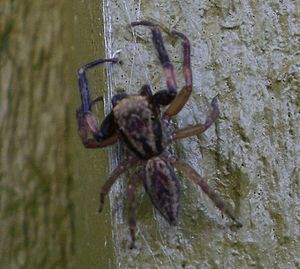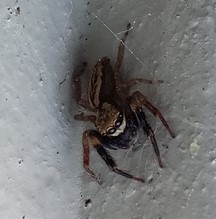Golden-brown jumping spider facts for kids
Quick facts for kids Golden-brown jumping spider |
|
|---|---|
 |
|
| Scientific classification | |
| Synonyms | |
|
Trite auricoma, also called the golden-brown jumping spider, is a type of jumping spider. It lives only in New Zealand, meaning it is endemic there.
Contents
About the Golden-Brown Jumping Spider
Adult golden-brown jumping spiders are about 8.4 to 8.8 millimeters long. That's less than a centimeter! Their body, called the cephalothorax, is dark brown. It looks flat and rectangular. The spider's belly, or abdomen, often has patterns of grey-brown and orange.
When male spiders are fully grown, they have a yellow band on their face. This band looks a bit like a mustache. Female spiders do not have this special mark. Males also have a thinner body and longer front legs than females.
How the Spider Got Its Name
The name "auricoma" comes from Latin words. "Auri" means gold, and "coma" means hair. So, "auricoma" means "gold hair." This name likely refers to the spider's golden-brown color.
Where Trite auricoma Lives
You can find Trite auricoma all over New Zealand. These spiders often hide in rolled-up leaves of flax plants. They also like to live under fallen leaves from cabbage trees. Sometimes, you can find them under stones, in plants, or even on the ground.
What the Golden-Brown Jumping Spider Eats
Like all spiders, Trite auricoma is a carnivore. This means it only eats other animals. Young spiders have been seen eating tiny insects like aphids and small flies. Adult spiders are more picky about their food. They prefer small flies and a type of fly called tachinids.
These spiders also learn what is good to eat. For example, young spiders might try to eat a slater (a small bug) once. But they usually learn not to eat them again after that first try!
How Trite auricoma Behaves
Hunting for Food
Trite auricoma is a visual hunter, just like most jumping spiders. This means they use their excellent eyesight to find food. If a fly is within 15 centimeters in front of the spider, it gets ready to hunt.
First, the spider straightens its legs and body. Then, it pulls its back legs in and slowly moves towards its prey. When the spider is about 3 to 4 centimeters away, it leaps! It then uses its fangs to catch the prey.
If prey appears behind the spider, it will turn around. It then starts to stalk the prey. If the prey moves, the spider turns its head to keep looking at it. Its body then moves into line, and it continues stalking. If the prey tries to run away, the spider will chase it and pounce. Spiders usually start hunting when they are hungry.
Young Trite auricoma spiders need to practice hunting. They often miss their prey a few times before they become good hunters.
Meeting Other Spiders
When Trite auricoma spiderlings (baby spiders) are still in their egg sac, they don't react to each other. But once they hatch, things change. If two young spiders meet, one or both will raise their front legs. After this, both spiders usually back away from each other.
Spider Parasites
Sometimes, Trite auricoma spiders can be attacked by a type of wasp called Priocnemis nitidiventris. This wasp will paralyze the spider. Then, it uses the spider as food for its young.
See also
 In Spanish: Trite auricoma para niños
In Spanish: Trite auricoma para niños


